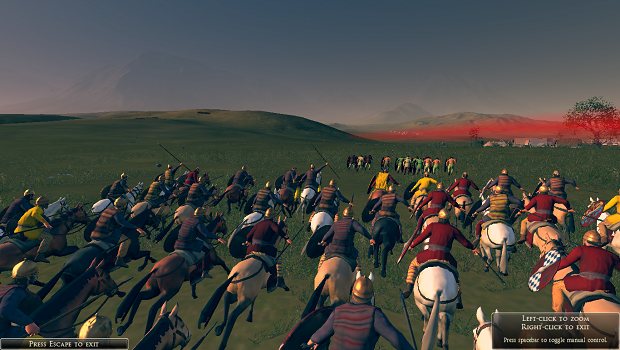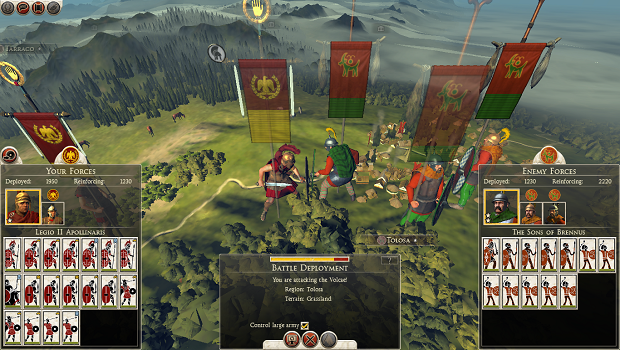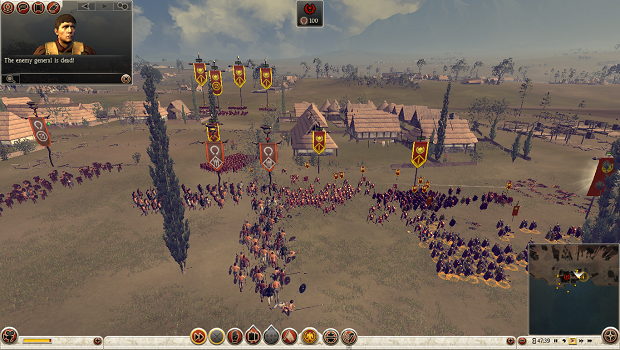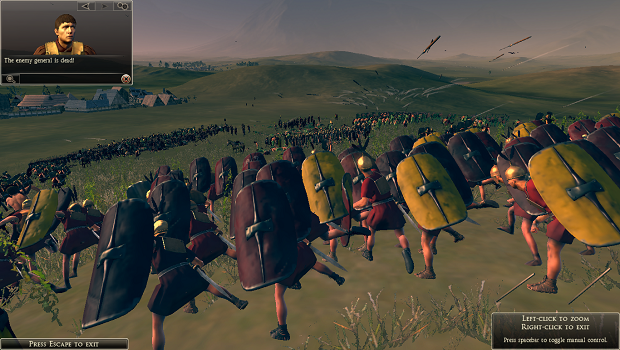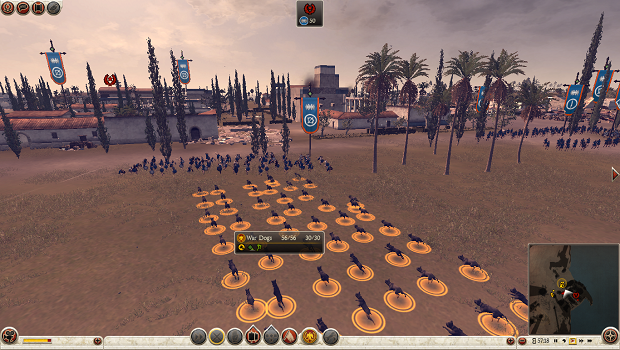The sun shined bright over the village. Birds flew swiftly over green fields, while deer grazed in the meadow. It was a beautiful day, an idyllic world. And yet, the beauty was haunted by foreboding. For the gods had decreed in the annals of history, the Fates had already woven the strings. This day, men would die.
Total War: Rome 2 is the latest installment in one of strategy gaming’s most revered franchises. It is a sequel of sorts to Rome: Total War, a wonderful title released nine years ago but sorely in need of a modern update. Rome 2 also represents a departure of sorts for the series, altering many game systems, increasing the number of units of the field, improving the graphics, introducing new political and faction systems, and offering massive maps, both at the strategic campaign level and in the real-time tactical level.
The Gaulic nation, under the chieftain Vercingetorix, formed to the front of my legions. Their right rested on a small hill, partially concealed by trees, with their center shielded by the village, and their left hanging in midair. The center was their weakness. I would use the village as the center of my encirclement, pinning and breaking their army against it. Legio I Italia would strike to the forest, and Legio II Apollonia would hit the flank in the air. My might, concentrated, would easily break the flanks, and trap the remaining Gauls in the center, where, surrounded, they would be massacred.
The campaign has been fundamentally transformed in a number of areas. For starters, the fundamental building block of armies in all previous series was the individual unit. In Rome 2, that building block is the army. Each army (or Legion in the case of Rome) has a name, like Legio I Italia, and a leader. Armies recruit units directly; you will no longer have individual, leaderless units running around the map. This eases the army management aspects of the game, since you no longer have to reinforce armies by recruiting units in cities and marching them out individually. You’ll also have fewer armies, as the number is capped based on your territorial holdings. Expand, and you’ll gain more armies. I like the change for several reasons. First, it greatly streamlines play. Secondly, it makes modeling things like a manipular legion (which had a very specific mix of units types) much easier. But most importantly, it concentrates units for both the player and the AI, resulting in much more frequent epic battles than ever before.
To confuse my foe, I assaulted en echelon, with Legio II hitting first, and as the enemy center moved to meet that threat, hit their opposite flank with Legio I. The hastati, my front rank of infantry, launched a volley of javelins and plunged into the foe. Their front line was mostly slingers, much better at tossing rocks than fighting swordsmen hand to hand. They were badly scattered, and those units that did not run were decimated. The hastati then began to encounter the enemy infantry, levy freedmen with sword and shield. I did not wait, but instead committed my principes, my second line of infantry. Armored more heavy, they punched into the enemy as a mailed fist, pushing both of the enemy flanks back into their center. It was then that Vercingetorix took me completely by surprise.
The game no longer differentiates between naval and land battles, as encounters on the tactical battle map can include both. It is a welcome change that makes siege battles much more entertaining. Assaulting the walls of an enemy city with one army, while your navy fights the enemy fleet garrison and lands on the shore is immensely compelling. It also means that a fleet does not necessarily need a supporting army to take a city; it can land its ships on the shore and have its men march into the city to capture it on their own. I must say I noticed a few bugs in this regard. Sometimes, one of my ships would get stuck on the shoreline midlanding, and I was unable to either send it back out to sea or march the troops off of it. But the vast majority of the time, it worked in spectacular and enjoyable fashion. The battles are wonderfully cinematic, with the game including a cinematic viewing angle, allowing you to hop right into a shield’s eye view of the action. Additionally, there is a new tactical view, allowing you to plot your battlefield maneuvers in more exacting fashion, and without the confusion of hundreds of men cluttering things up. The battles are addictive, engrossing, and everything you would hope for from a series entering its eighth iteration.
The forest off to the enemy right did not only conceal the right of their line. As the front lines of Legio I rolled the enemy right back into their center, they themselves were struck in the flank and rear by Celtic horsemen, emerging from their concealment behind the trees. It was also this moment that Vercingetorix himself charged at the head of his bodyguard into the fight against Legio I. My surprised troops, having pushed back the enemy so easily till now, reeled. Some of the frontline units began to waiver. But I had yet one more card up my sleeve as well.
The map is now divided into provinces of 2-4 cities apiece, with one being a walled capital, and the rest being unwalled minor cities. I wish this wasn’t a hard and fast rule. One of the most famous walled cities of the ancient world, Syracuse, loses those walls because of its minor city status. Minor historical quibbles aside, the new province system greatly eases province management, enabling you to run four cities at once. This greatly reduces the tedium you used to experience as your empire grew in size, and you had to individually manage every city. The map itself is massive; scrolling from one side of the map to the other takes a long, long time. It’s a huge world with a lot of different civilizations, maybe too many. As you move through the turn-based campaign, you’ll notice that the time between your turns, as each civilization moves on its own, one by one, is considerable. Still, between moving your armies, fighting battles, engaging in diplomatic negotiation, developing your territories and researching technologies, there’s a lot to do. I just wish I didn’t have to wait quite so long to do it. The large number of civilizations does provide the player many different ways to play. Other than the Romans, there are a large number of playable factions in the game. The Britons, Egyptians, Macedonians, Carthaginians, and Thracians are but a few. And more are on the way. The Selucids have been announced as a free download for next month.
As the Roman anodyne says, the last resource is in the triarii. As my troops wavered, I committed my third and final line of infantry, the heavily-armored and deeply-experienced triarii, to the battle. Their spears repulsed the enemy cavalry, and their charge completed the encirclement of the enemy center. Legionaries began a systematic and disciplined slaughter of the foes. Bodies were strewn about the ground as Gaul climbed over Gaul, desperate to escape. My unrelenting Romans cut them down.
Despite the wonderfully cinematic battles and the improvements to streamline the campaign, I do have a few nits to pick. The tutorial, while informative, is really, really long and also includes the distinct possibility of mission failure. That failure will cause you to have to go all the way back to the beginning. Worst still, there are three separate parts to the tutorial. As a veteran player, I had to complete the long (and for a player of my skill level, completely unnecessary) battle tutorial to learn anything about the campaign map. While the battle system is pretty intuitive, the campaign map is not, and locking the tutorial away is a misstep.
An additional painful issue is the enemy AI. It tends to make really odd decisions on the campaign map. As a huge army of mine approached Syracuse, the Syracusan army in its entirety put to sea and ran away. This left their faction’s only city completely undefended. After the city was taken, their army scattered, and made piecemeal, suicidal attacks against my cities, repeating every turn until they were completely destroyed. Additionally, the unit AI in naval battles is weak, at best. In smaller engagements, where you can exert control over all your units, it isn’t an issue. But in larger naval battles, units will, for instance, ram an opponent once and then wait for further orders. In a massive naval melee, the lack of any individual unit AI is painfully obvious. So, yes, the game has some bugs. They are by no means game breaking, but they are noticeable.
Total War: Rome 2 is a bit of a departure from previous games. By and large, the alterations succeed, resulting in a fun, addicting, and distinctly Roman-era game. Yet, it’s difficult to ignore the game’s warts. Creative Assembly does have an extensive history of supporting these titles post-release, but if some of what I have mentioned concerns you, you might wish to wait to see where future patches land. As for me:
Vercingetorix was among the last to fall, he and his bodyguard falling to my encircling soldiers. He was a determined opponent, one who I am sure will be long remembered by his gods. Mars, however, is triumphant, as six of the foe fell for every one of ours. With this victory, the door to Provence and the south of Gaul is wide open. The Eagle shall soon be raised from the Mare Nostrum to the shore of Brittania!
Total War: Rome II was reviewed on a retail Steam code for the game provided by the developer.
